In 2025, a staggering 2.5 billion people worldwide actively use Gmail, making it an undeniable titan in the digital communication landscape.
This isn’t just a number; it represents a global reliance on a platform that seamlessly blends personal connection with professional productivity.
Whether you are a student, a small business owner, or part of a large enterprise, understanding Gmail’s immense reach and evolving features can significantly enhance your digital life and help you leverage its power for your benefit.
Gmail doesn’t just boast a massive user base; it actively shapes how we send and receive information. It handles an impressive 30% of global email traffic, processing an astonishing 121 billion emails daily.
This means that nearly one in three emails sent around the world passes through Gmail’s powerful infrastructure. The platform also experiences a colossal 66.64 billion monthly visits, highlighting its consistent engagement and importance to users.
This article delves into the latest Gmail statistics for 2025, examining its market share, user demographics, usage patterns, and innovative features, offering insights to enhance your Gmail experience.
The Ever-Growing Family: How Many People Use Gmail?
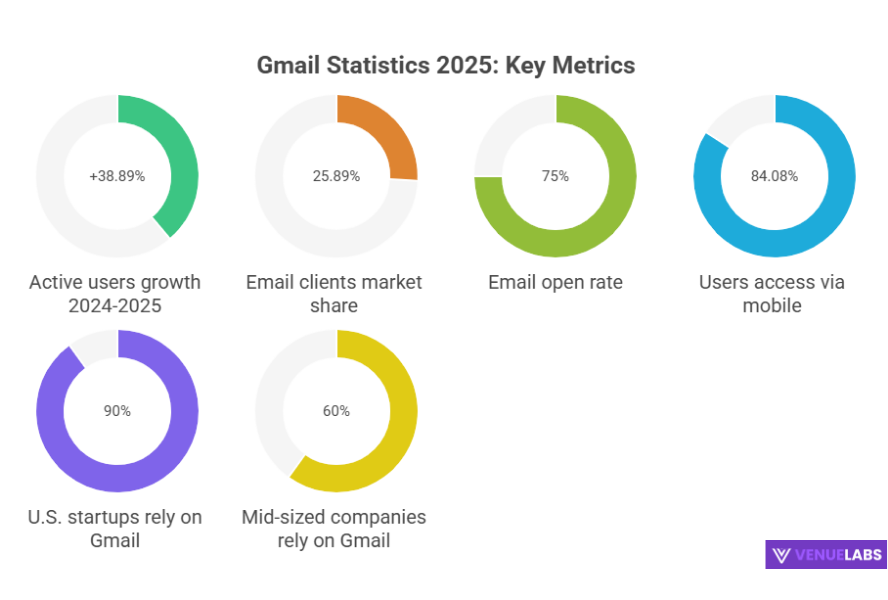
Gmail’s user growth has been nothing short of phenomenal. From humble beginnings, it has consistently expanded its reach, becoming a cornerstone of online interaction for billions. This growth speaks volumes about its reliability and the continuous innovation Google brings to the platform.
As of 2025, a remarkable 2.5 billion people are active Gmail users across the globe. This makes it the second most popular email client, solidifying its position as a primary communication tool for a significant portion of the world’s internet users.
The official Gmail website, mail.google.com, alone attracts an average of 66.64 billion monthly visitors, demonstrating the consistent and widespread engagement with the service.
This high volume of traffic isn’t surprising when we consider how deeply integrated Gmail is into our digital lives, especially for Android users who often rely on it as their default email client.
The numbers don’t lie. Hundreds of thousands of companies are actively choosing Gmail for their email management needs, further underscoring its professional appeal.
This growing adoption by businesses, from startups to established enterprises, highlights its robust features and seamless integration within the Google Workspace ecosystem.
- Also read about: Email Marketing Statistics
Growth of Gmail Users Over Time
The following table vividly illustrates the exponential growth of Gmail’s user base, showcasing its journey to becoming a global communication powerhouse.
| Year | Number Of Users |
| 2025 | 2.5 billion |
| 2024 | Over 1.8 billion |
| 2020 | 1.8 billion |
| 2019 | 1.7 billion |
| 2018 | 1.5 billion |
| 2017 | 1.3 billion |
| 2016 | 1 billion |
| 2015 | 900 million |
| 2014 | 750 million |
| 2013 | 600 million |
| 2012 | 425 million |
Source: The Tech Report., Economic Times
Who is Using Gmail? Understanding User Demographics
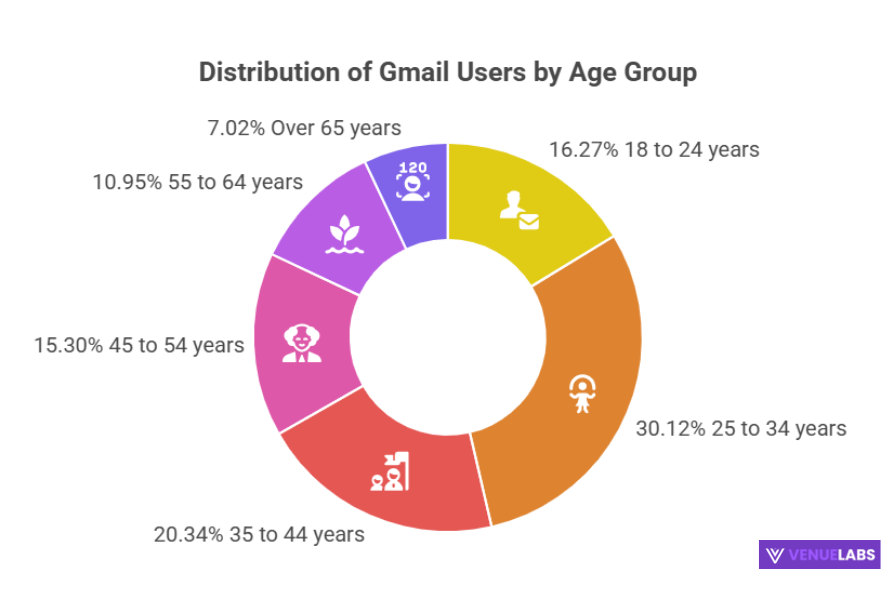
Understanding the demographics of Gmail users helps us see who is benefiting most from this powerful tool. The user base is diverse, but certain trends emerge, painting a clearer picture of Gmail’s primary audience.
Gender distribution among Gmail users shows a slight leaning towards male users, with 53.05% being male and 46.95% being female. This near-even split indicates that Gmail caters to a broad audience, regardless of gender.
Age-wise, Gmail proves particularly popular among younger adults and professionals. The largest segment of Gmail users falls within the 25 to 34 age group, accounting for 30.12% of all Gmail accounts. This demographic often represents individuals in their early to mid-careers, relying heavily on email for both personal and professional communications.
Gmail Users by Age Group
Here is a detailed breakdown of Gmail users across various age categories, illustrating the platform’s appeal to different generations.
| Age Group | Share Of Gmail Users |
| 18 to 24 years | 16.27% |
| 25 to 34 years | 30.12% |
| 35 to 44 years | 20.34% |
| 45 to 54 years | 15.30% |
| 55 to 64 years | 10.95% |
| Over 65 years | 7.02% |
Dominating the Inbox: Gmail’s Market Share
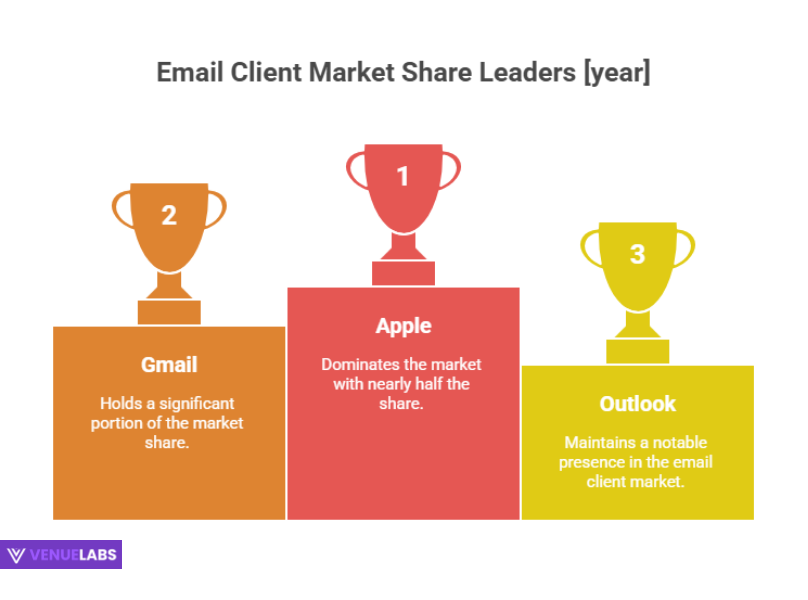
In the competitive landscape of email clients, Gmail stands out as a clear leader. Its robust features, seamless integration with other Google services, and strong security measures contribute to its significant market presence.
As of 2025, Gmail commands a impressive 25.89% of the worldwide email client market share in terms of email opens. This positions it as the second most popular platform globally, closely following Apple MPP.
While Apple MPP leads in market share, Gmail’s consistent performance and widespread adoption highlight its critical role in digital communication. Major competitors like Outlook and Yahoo! Mail hold significantly smaller shares, further emphasizing Gmail’s dominance.
- Also read bout: Google Chrome Statistics
Email Client Market Share Comparison 2025
This table provides a clear picture of how Gmail’s market share stacks up against other prominent email clients, showcasing its strong competitive standing.
| Email Client | Market Share |
| Apple | 49.42% |
| Gmail | 25.89% |
| Outlook | 3.63% |
| Yahoo! Mail | 2.2% |
| Google Android | 1.21% |
| QQ Mail | 1.05% |
| Outlook.com | 0.47% |
| Thunderbird | 0.18% |
| Orange.fr | 0.07% |
| Samsung Mail | 0.04% |
Source: Statista
Powering Google’s Ecosystem: Gmail’s Revenue Growth
While Gmail offers its core services for free, it plays a vital role in Google’s overall revenue strategy, primarily through its paid subscriptions that offer increased storage and enhanced features. The platform’s in-app revenue has experienced explosive growth, demonstrating the value users find in these premium offerings.
Since 2021, Gmail’s in-app revenue has surged by an astounding 179 times. This dramatic increase reflects a growing trend of users investing in their digital workspace, particularly for expanded storage and improved productivity.
In July 2023, Gmail’s net revenue from the App Store reached an estimated $7.3 million. This represents a significant jump from January 2023, when it was approximately $5.1 million, and an even more impressive leap from January 2022, when it stood at just $1 million. This means Gmail’s net revenue grew an incredible 630% in just a year and a half from the App Store alone!
This revenue primarily comes from subscriptions that allow users to expand their inbox storage, with the 100GB plan proving to be the most popular choice. It’s important to note that for Android users, these purchases often go through the Google One app, which also contributes to Google’s overall revenue stream.
- Also read about: Google Ads Statistics
The Heartbeat of Communication: Gmail Usage Statistics
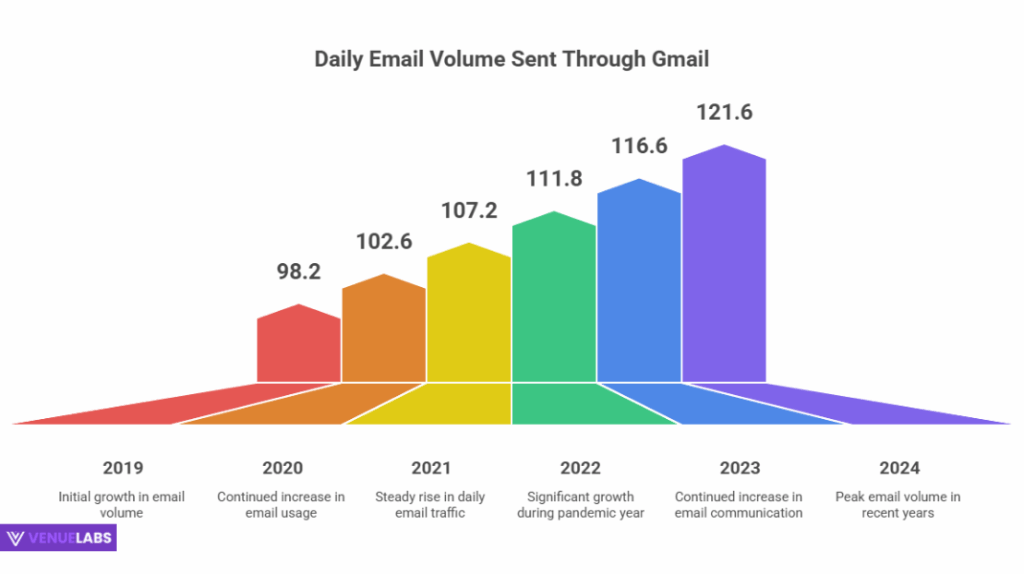
Gmail isn’t just a platform; it’s a dynamic hub for constant communication. The sheer volume of emails processed daily and the average time users spend on the platform highlight its integral role in our digital lives.
Each day, over 121 billion emails are sent using Gmail. This staggering figure represents a significant portion of the global email exchange. Considering that approximately 347 billion emails are sent worldwide daily, Gmail is responsible for an impressive 30.01% of the total global email volume.
Daily Email Volume Sent Through Gmail
The following table illustrates the consistent growth in the number of emails sent daily through Gmail over recent years.
| Year | Emails Sent Daily (Billion) |
| 2025 | 121 |
| 2024 | 121.6 |
| 2023 | 116.6 |
| 2022 | 111.8 |
| 2021 | 107.2 |
| 2020 | 102.6 |
| 2019 | 98.2 |
Users engage actively with Gmail, spending an average of 28 minutes on the platform every day. This substantial daily engagement indicates that Gmail is more than just a quick check; it’s a workspace where people manage a significant part of their daily communications. On average, a worker receives 121 emails per day, underscoring the constant flow of information that Gmail users navigate.
Gmail also accounts for 27% of all email views on the internet, further solidifying its position as a primary gateway to email content. To cater to its diverse global user base, Gmail is available in 105 languages, making it accessible to a vast international audience.
The business world heavily relies on Gmail. An impressive 90% of startup businesses in the United States utilize Gmail accounts, and over 60% of mid-sized US companies have reported using Gmail for professional purposes. This widespread adoption in the business sector highlights Gmail’s scalability, reliability, and the comprehensive features it offers for organizational communication.
On average, a user maintains about 1.7 Gmail accounts, indicating the common practice of having separate accounts for personal, professional, or specific online activities. During a single visit, a user typically navigates through 9 pages, and the average duration of a visit on Gmail is 12 minutes and 42 seconds. This suggests that users often engage in multiple tasks and explore different aspects of their inbox during a session.
A Global Presence: Gmail Usage by Country
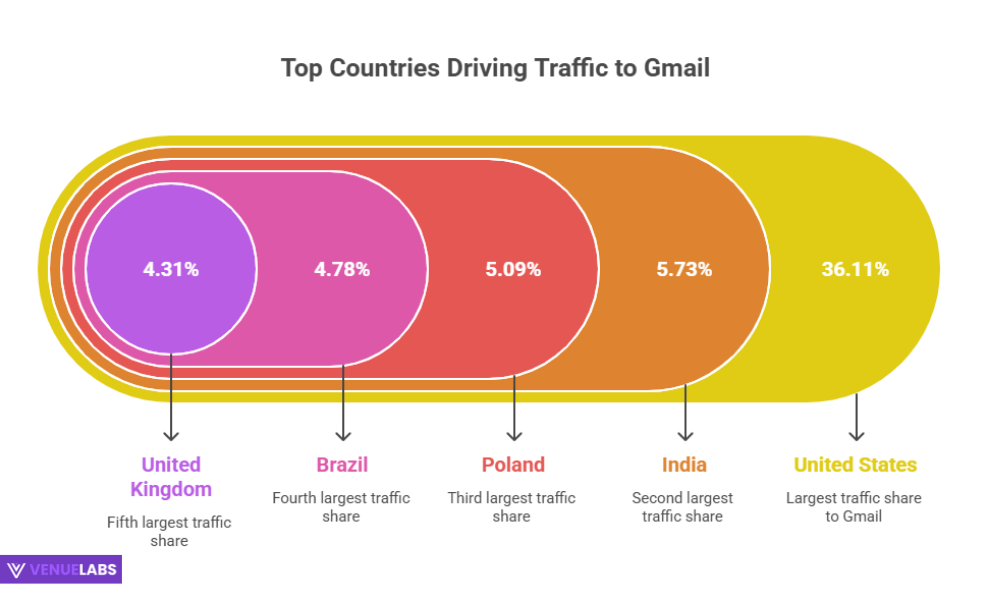
Gmail’s influence spans the globe, with users from every corner of the world relying on its services. However, certain regions contribute more significantly to its overall traffic.
The United States stands as the largest source of Gmail traffic, contributing 36.11% of its total visits. This substantial share reflects the strong digital infrastructure and high internet penetration in the US, as well as the deep integration of Google services into American daily life.
Other countries also contribute significantly to Gmail’s global traffic, showcasing its international appeal. India, for instance, accounts for 5.73% of the traffic, while Poland, Brazil, and the United Kingdom also represent substantial user bases.
Countries Directing Highest Share of Traffic to Gmail
This table highlights the top countries that funnel the most traffic to Gmail, demonstrating its geographical reach.
| Country | Share Of Traffic |
| United States | 36.11% |
| India | 5.73% |
| Poland | 5.09% |
| Brazil | 4.78% |
| United Kingdom | 4.31% |
On the Go: Gmail Usage by Device
In our increasingly mobile-first world, how users access their email is crucial. Gmail’s design and functionality cater perfectly to this trend, allowing users to stay connected wherever they are.
An overwhelming majority of Gmail users, 84.08%, access their emails through their mobile devices. This statistic underscores the dominance of smartphones and tablets in our daily lives and how essential mobile access to email has become. In contrast, only 15.92% of users prefer to access Gmail on a desktop computer.
Gmail Users by Device
This table clearly illustrates the preference for mobile access among Gmail users.
| Device | Percentage Of Gmail Users |
| Desktop | 15.92% |
| Mobile | 84.08% |
Engaging the Audience: Gmail Engagement Rates
Beyond simply receiving emails, how users interact with them is a critical measure of an email client’s effectiveness. Gmail consistently demonstrates high engagement rates, making it a powerful platform for communication and marketing.
Gmail boasts an impressive open rate of 75%. This means that three out of four emails sent to Gmail users are opened, a remarkably high figure compared to its competitors.
For instance, Yahoo Mail records an open rate of only 14.8%. This high engagement makes Gmail an incredibly effective channel for both personal and business communications.
Email Open Rates Across Different Platforms
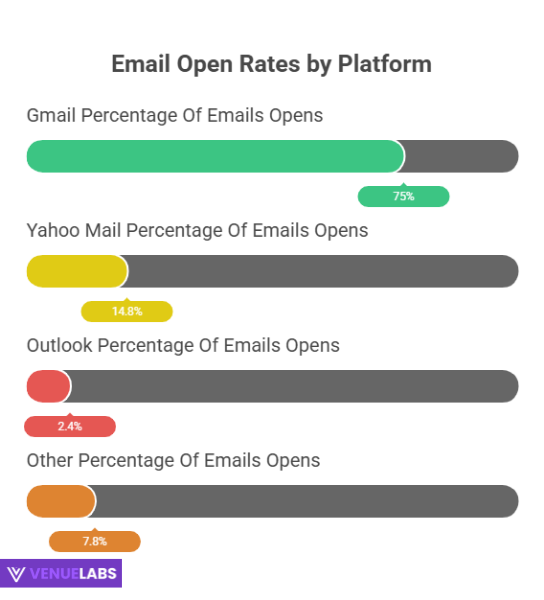
This table compares Gmail’s open rates with other major email platforms, highlighting its superior engagement.
| Email Platform | Percentage Of Emails Opens |
| Gmail | 75% |
| Yahoo Mail | 14.8% |
| Outlook | 2.4% |
| Other | 7.8% |
While Gmail generally enjoys high open rates, it’s interesting to note that only 9% of sales emails are opened, while the rest are often ignored. This suggests that users are discerning about promotional content.
However, urgency can play a role, as 24% of emails are opened within an hour of being received, emphasizing the importance of timely communication. On average, users delete about 50% of the emails they receive, highlighting the need for relevant and engaging content to stand out in a crowded inbox.
Sales professionals spend over 33% of their time on emailing, further emphasizing the importance of an efficient and reliable email platform like Gmail for business operations.
One of Gmail’s most celebrated features is its spam filtering, with less than 0.1% of emails in an average Gmail account being reported as spam. This robust filtering system contributes significantly to a cleaner and more manageable inbox.
Gmail also categorizes incoming messages using various tags. A significant portion of messages, 84.5%, are tagged as promotional, often appearing in the “Promotions” tab.
However, these emails have the lowest read rates, with only 19.2% being opened. Conversely, emails tagged as “Social” acquire 87.2% of the inbox, indicating high engagement with social media notifications.
Share of Emails with Different Tags in the Inbox
This table details the distribution of email tags within the Gmail inbox, offering insights into user preferences and engagement.
| Tag Name | Percentage Of Messages |
| Promotions | 84.5% |
| Social | 87.2% |
| Updates | 86.8% |
Instant Access: Gmail App Statistics 2025
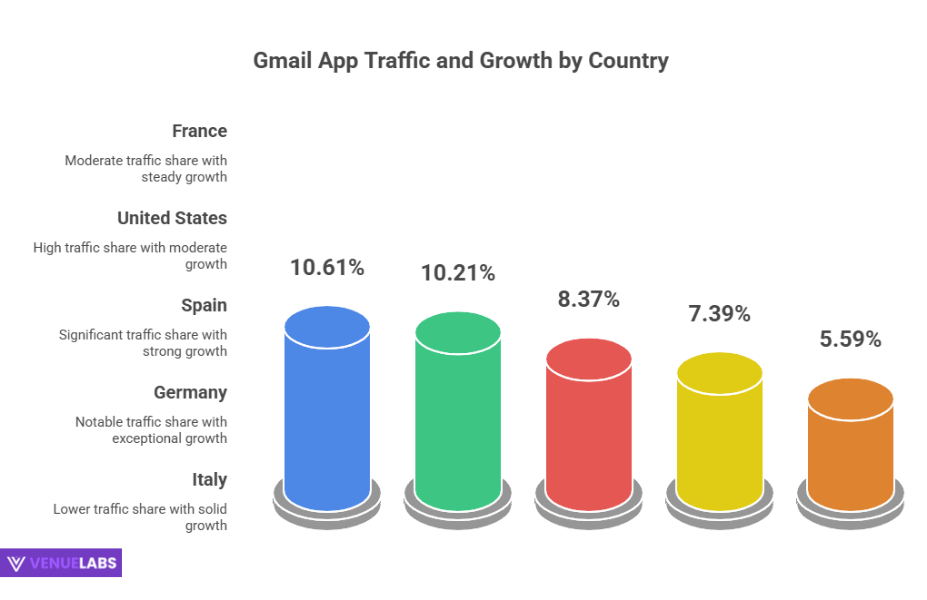
The Gmail mobile app is a powerhouse for quick and efficient email management. In 2025, the Gmail app recorded 2.44 million monthly visits worldwide.
Its primary use case revolves around fast email checks and rapid replies, which explains the relatively short average session duration of just 7 seconds and a high bounce rate of 89.13%. Users open the app, quickly scan their inbox, respond to urgent messages, and then move on.
The majority of Gmail app traffic originates from European and U.S. users, reflecting strong smartphone adoption and reliance on mobile email in these regions.
Gmail App Traffic by Country 2025
This table shows the geographical distribution of Gmail app traffic, along with month-over-month growth rates.
| Country | Share of Traffic | MoM Growth |
| France | 10.61% | +12.07% |
| United States | 10.21% | +9.68% |
| Spain | 8.37% | +22.60% |
| Germany | 7.39% | +110.36% |
| Italy | 5.59% | +17.11% |
The Journey of an Email Giant: Gmail History
| Year / Period | Event / Milestone | Description |
| 1971 | First email sent | Ray Tomlinson sends the very first email on ARPANET, introducing the “@” symbol to separate username and host. |
| 2001 | Gmail development begins | Paul Buchheit starts developing Gmail in JavaScript, a cutting-edge choice for its time. |
| 2001–2004 | Birth of Gmail | The period marking the actual creation and internal development of Gmail. |
| April 1, 2004 | Gmail public launch | The concept of the first public Gmail account emerges, marking its official availability. |
| 2005 | Industry recognition | Gmail is ranked second in “100 Best Products of 2005” by PC World and receives an “Honourable Mention” in design awards. |
| 2006 | Best webmail service | Forbes magazine declares Gmail the best webmail service provider globally. |
| 2013 | Storage expansion | Google provides users with a generous 15 GB of free storage, setting a new standard. |
| 2021 | High search interest | “Gmail” becomes the 12th most searched query, reflecting its widespread public recognition. |
| Ongoing | Longest outage | Google experiences a rare, but notable, 2.5-hour service outage. |
| 2025 | AI security warnings | Gmail actively warns its 2.5 billion users to stay vigilant against evolving AI hacking attacks |
What Users Are Asking: Insights from Quora and Reddit
Beyond the official statistics, online communities like Quora and Reddit provide a pulse on what real users are experiencing and asking about Gmail. This “real-time” feedback offers valuable qualitative insights that complement the quantitative data.
One recurring theme on these platforms revolves around privacy and security concerns, especially in light of increasing data breaches and AI-powered phishing attempts.
Users frequently ask about the effectiveness of Gmail’s spam filters, how to enhance account security beyond two-factor authentication, and what Google does with their data.
This reflects a growing awareness and demand for transparency regarding online privacy. Gmail’s AI-powered defenses block over 99.9% of spam, phishing, and malware emails, preventing nearly 15 billion unwanted emails daily, which directly addresses these concerns.
However, the threat landscape constantly evolves, as evidenced by a recent study revealing over 19 billion passwords compromised since April 2024, with only 6% being unique, reminding users to be diligent about password practices.
Another popular topic is managing a cluttered inbox and maximizing productivity. Users often seek advice on organizing emails, utilizing labels and filters effectively, and integrating Gmail with other productivity tools.
This points to a desire for more personalized and efficient email management, moving beyond simple sending and receiving. Questions about the best ways to reduce email overload and use features like “Snooze” or “Smart Reply” are common.
Furthermore, with the rise of AI, users are curious about Gmail’s integration with AI features, such as AI-powered writing assistance, automated summaries of long email threads, and enhanced search capabilities.
They want to know how AI can further streamline their email workflow and provide more intelligent interactions. This indicates an appetite for advanced, smart features that anticipate user needs.
Finally, many users are looking for ways to leverage Gmail for small business growth and marketing. They inquire about best practices for email marketing within Gmail, integrating with CRM systems, and using Gmail’s features to improve customer communication and outreach.
This highlights Gmail’s role not just as a personal communication tool but as a powerful platform for professional engagement. An impressive 92% of U.S. startups utilizing Gmail as their primary email provider underscores this trend.
These discussions reveal that users are actively seeking ways to make their Gmail experience more secure, productive, and intelligent, reflecting a growing sophistication in how they approach email communication.
FAQs About Gmail Statistics
1. How many people actively use Gmail in 2025?
As of 2025, a massive 2.5 billion people actively use Gmail around the globe, making it one of the most widely adopted email clients in the world.
2. What is Gmail's market share in 2025 compared to other email clients?
In 2025, Gmail holds a significant 25.89% share of the worldwide email client market based on email opens, ranking as the second most popular platform after Apple MPP.
3. How much time do users typically spend on Gmail daily?
On average, users spend approximately 28 minutes on Gmail every day, actively managing their communications and navigating through various emails.
4. Is Gmail primarily used on mobile devices or desktops?
The majority of Gmail users, specifically 84.08%, access their emails through their mobile devices, highlighting a strong preference for on-the-go communication.
5. How effective are Gmail's spam filters?
Gmail’s spam filters are exceptionally effective, with less than 0.1% of emails in an average Gmail account being reported as spam, ensuring a clean and secure inbox for its users.
Also Read:
- Pinterest Statistics
- Tumblr Statistics
- Google Searches Statistics
- Video Marketing Statistics
- eLearning Statistics
Conclusion: Gmail Defines the Future of Email in 2025
By the close of 2025, Gmail has unequivocally cemented its dominance in the digital communication landscape. With an astonishing 2.5 billion users worldwide, it doesn’t just manage email; it actively shapes its future.
The platform fuels a staggering 66.64 billion monthly visits and powers an incredible 121 billion daily emails, accounting for almost 30% of global email traffic. These figures are a powerful testament to Gmail’s immense scale and profound impact on how we connect and communicate.
Its exceptional 75% open rate stands head and shoulders above every major competitor, demonstrating a level of user engagement that is truly unparalleled.
This isn’t just a win for Gmail; it’s an opportunity for individuals and businesses to ensure their messages are seen and acted upon. The fact that 84.08% of users access Gmail via mobile devices highlights the ongoing shift towards mobile-first communication, a trend Gmail has expertly adapted to with its intuitive and efficient app.
On the business front, Gmail is the preferred choice for the modern enterprise. An impressive 90% of U.S. startups and over 60% of mid-sized companies rely on Gmail for their professional needs, showcasing its robust features, scalability, and seamless integration within the Google Workspace ecosystem.
This widespread adoption underscores its reliability and efficiency as a business communication tool. Furthermore, its in-app revenue has experienced an extraordinary 179x surge since 2021, indicating a strong user willingness to invest in enhanced features and storage, proving the tangible value Gmail provides.
Taken together, these comprehensive statistics paint a clear picture: Gmail isn’t merely growing; it is actively defining the scale, speed, and efficiency of modern email. It continuously innovates, adapts to user needs, and provides a secure, reliable, and highly engaging platform that billions depend on every single day.
For anyone seeking to navigate the digital world effectively, understanding and leveraging Gmail’s power is no longer an option – it’s a necessity.
